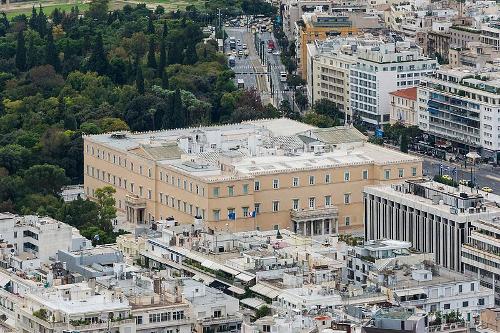NAXOS
Society

Society

Popular destinations GREECE
| Aegina | Alonissos | Andros |
| Chios | Corfu | Crete |
| Hydra | Kalymnos | Karpathos |
| Kefalonia | Kos | Lefkas |
| Lesbos | Mykonos | Naxos |
| Paros | Patmos | Peloponnese |
| Poros | Rhodes | Samos |
| Santorini | Skiathos | Skopelos |
| Spetses | Thasos | Zakynthos |
Society
State structure
 Greece VouliPhoto: Jebulon in the public domain
Greece VouliPhoto: Jebulon in the public domain
Greece received a new administrative division on January 1, 2011 as part of an overall administrative reform named after Kallikratis, a Greek architect from the mid-5th century BCE.
Greece has been divided into 13 administrative regions, known as "peripheries," since 2011. These administrative regions are in turn divided into 74 regional units, the "perifereiaki enotita". The regional units, which no longer have their own administration, are in turn subdivided into 325 municipalities or "demoi. In addition, since 1926 Greece has had one autonomous region under its own Greek Orthodox administration, namely Agion Oros or the monastic state of Athos in Chalkidiki (northern Greece).
The 13 administrative regions of Greece are Attica (1), Central Greece (2), Central Macedonia (3), Crete (4), Eastern Macedonia and Thrace (5), Epirus (6), Ionian Islands (7), Northern Aegean Islands (8), Peloponnese (9), Southern Aegean Islands (10), Thessaly (11), Western Greece (12) and Western Macedonia (13).
With the 2011 administrative reorganization, Naxos became a regional unit of the South Aegean Islands administrative region, which further consists of the islands of Andros, Kalymnos, Karpathos, Kea-Kythnos, Kos, Milos, Mykonos, Paros, Rhodes, Syros, Santorini (Thira) and Tinos.
Naxos belongs geographically to the Central and Eastern Cyclades, which also includes Paros and Antiparos. In addition to the Central and Eastern Cyclades, there are also the Western Cyclades (which includes Kythnos, Melos and Serifos), the Northern Cyclades (which includes Andros, Mykonos, Tinos and Syros), the Small Cyclades (which includes Iraklia, Keros and Donousa) and the Southern Cyclades (which includes Folegandros, Ios and Santorini). For the current political situation in Greece, see History section.
Education
-During the Turkish occupation, the present Archaeological Museum, then the Sanudo Palace, housed a French Jesuit trade school. The school was founded in 1670 and remained in use as an educational institution until 1970. Most famous student of this school was the author of the famous novel "Zorba the Greek", the Cretan Nikos Kazantzákis. He went to school here in 1896.
-In the village school of Aperanthos there is a Geological Museum.
The marble of Naxos
It is hard to believe that there is only one area on Naxos where marble has been mined since prehistoric times. And yet it's just a group of five mountains near Kynidaros, 15 km east of Naxos Town, that has been supplying marble to artisans and artists since the Neolithic era. So even today, Naxos is known for its refined, shiny marble, known commercially as Naxos Crystalline. Evidence of the centuries-long production of marble can be seen in the harbor of Naxos Town, where the marble Portara Gate from the 6th century BCE stands near a 21st century statue of Ariadne, both made of Naxos marble. And all over Naxos and on other islands in the Aegean and beyond, buildings, monuments and sculptures are and have been made of Naxos marble.
There are several factors that make the marble of Naxos so unique, but its fantastic brilliance makes it one of the most popular types of marble. That brilliance is caused by the composition of the marble, which consists of 2% quartz and 98% the mineral calcite. In addition, it is less porous than other marble types, making it more durable and less susceptible if tampered with. The marble is used for tiles, facades, floors, stairs and, of course, for works of art.
There are three qualities of Naxos marble: white is the most exclusive of the three and accounts for 20% of production; semi-white, the most commercial of the three accounts for 50% of production and the gray variety, which accounts for 30% of production.
Another special feature is that the marble in the quarries rests on a vertical slope rather than a horizontal slope, as is almost always the case. The limited amounts of marble left to be extracted make Naxos marble very special and expensive.
The quarries in the area of Kynidaros are known as: Sanidas (the oldest and still in use); Zas (three quarries); Bolimbas (the largest quarry; Diracha; and Amelathiou and Skaretzou (which are inactive at present).
Sources
Wikipedia
CIA - World Factbook
BBC - Country Profiles
Last updated June 2025Copyright: Team The World of Info